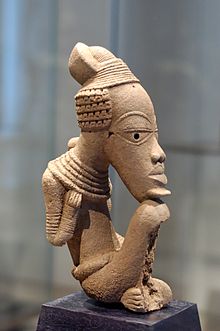Budaya Nok
9°30′N 8°0′E / 9.500°N 8.000°E

Budaya Nok muncul di Nigeria sekitar 1000 SM dan menghilang dalam keadaan yang tidak diketahui sekitar tahun 300 di wilayah Afrika Barat. Wilayah ini terletak di Utara dan Nigeria. Sistem sosial ini diperkirakan telah sangat maju. Budaya Nok dianggap sebagai produsen sub-Sahara awal seukuran Terakota asli.
Penyempurnaan budaya ini dibuktikan oleh citra Pembesar Nok di MIA. Pembesar ini digambarkan mengenakan "tongkat bengkok" ([1], [2]). Pembesar ini juga digambarkan duduk dengan lubang hidung melebar, dan menunjukkan mulut terbuka. Gambar lain menunjukkan angka di atas kuda, mengindikasikan bahwa budaya Nok memiliki kuda.
Penggunaan besi, di alat bantu peleburan dan tempa, muncul dalam budaya Nok di Afrika setidaknya 550 SM dan kemungkinan lebih awal. Christopher Ehret telah menyarankan bahwa peleburan besi secara terpisah ditemukan di wilayah ini sebelum 1000 SM.[3][4][5]
Catatan
sunting- ^ 'The discovery of the widespread Nok culture and the recognition it was ancestral to the later highly developed Yoruba art of Ife' Chambers Encyclopaedia New Revised Edition, Volume 10 page 40, International Learning Systems Corporation Ltd London
- ^ The Yoruba are a people of great antiquity and have a record of impressive achievements in many fields of human activity. The Yoruba trace royal genealogies as far back as the 12th century but higher forms of political and social organizations have existed among the Yoruba for much longer: it is thought they may have developed as early as the 1st millennium BC, and archaeological discoveries in the Nok valley and on the island of Jebba on the Niger substantiate this' The New Universal Library Volume 14 Page 456 The Caxton Publishing Company London
- ^ Jared Diamond, 'Guns, Germs, dan Steel: The Fates of Human Societies' (1997) Chapter 19
- ^ Duncan E. Miller and N.J. Van Der Merwe, 'Early Metal Working in Sub Saharan Africa' Journal of African History 35 (1994) 1-36
- ^ Minze Stuiver and N.J. Van Der Merwe, 'Radiocarbon Chronology of the Iron Age in Sub-Saharan Africa' Current Anthropology 1968. Tylecote 1975 (see below)
Referensi
sunting- Atwood, R. (2011). The NOK of Nigeria. Archaeology July/August 2011, 34-38.
- Breunig, P. (ed.) (2013). Nok - Ein Ursprung afrikanischer Skulptur. Frankfurt: Africa Magna Verlag. ISBN 978-3-937248-38-7
- Breunig, P. & Rupp, N. (2006). Nichts als Kunst. Archäologische Forschungen zur früheisenzeitlichen Nok-Kultur in Zentral-Nigeria. Forschung Frankfurt 2-3, 73-76.
- Boullier, C.; A. Person; J.-F. Saliège & J. Polet (2001). Bilan chronologique de la culture Nok et nouvelle datations sur des sculptures. Afrique: Archéologie & Arts 2, 9-28.
- Fagg, A. (1972). A preliminary report on an occupation site in the Nok valley, Nigeria: Samun Dukiya, AF/70/1. West African Journal of Archaeology 2, 75-79.
- Fagg, B. (1959). The Nok Culture in prehistory. Journal of the Historical Society of Nigeria 1 (4), 288-293.
- Fagg, B. (1968). The Nok Culture: Excavations at Taruga. The West African Archaeological Newsletter 10, 27-30.
- Fagg, B. (1969). Recent work in West Africa: new light on the Nok Culture. World Archaeology 1 (1), 41-50.
- Fagg, B., (1990): Nok terracottas. Lagos: National Commission for Museums and Monuments.
- Jemkur, J. (1992). Aspects of the Nok Culture. Zaria.
- Rupp, N.; Ameje, J.; Breunig, P. (2005). New studies on the Nok Culture of Central Nigeria. Journal of African Archaeology 3, 2: 283-290.
- Rupp, N.; Breunig, P.; Kahlheber, S. (2008). Exploring the Nok enigma. Antiquity, Project gallery. Online publication: http://www.antiquity.ac.uk/ProjGall/kahlheber/index.html
- Shaw, T., (1981). The Nok sculptures of Nigeria. Scientific American 244(2): 154-166.
- Tylecote, R. (1975a). The origin of iron smelting in Africa. Westafrican Journal of Archaeology. 5, 1-9.
- Tylecote, R. (1975b). Iron smelting at Taruga, Nigeria. Journal of Historical Metallurgy 9 (2), 49-56.
- Olubunmi A.O.(2007) The Rise and Fall of The Yoruba Race, The 199 Publishing Palace ISBN 978-2457-38-8
- Olubunmi A.O.(2009) On Ijesa Racial Purity, The 199 Publishing Palace ISBN 978-2458-17-1
- Ayoade J.O.(1983) Introduction To Climatology For The Tropics, John Wiley & Sons ltd UK ISBN 0-471-10407-8